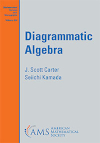- About MAA
- Membership
- MAA Publications
- Periodicals
- Blogs
- MAA Book Series
- MAA Press (an imprint of the AMS)
- MAA Notes
- MAA Reviews
- Mathematical Communication
- Information for Libraries
- Author Resources
- Advertise with MAA
- Meetings
- Competitions
- Programs
- Communities
- MAA Sections
- SIGMAA
- MAA Connect
- Students
- MAA Awards
- Awards Booklets
- Writing Awards
- Teaching Awards
- Service Awards
- Research Awards
- Lecture Awards
- Putnam Competition Individual and Team Winners
- D. E. Shaw Group AMC 8 Awards & Certificates
- Maryam Mirzakhani AMC 10 A Awards & Certificates
- Two Sigma AMC 10 B Awards & Certificates
- Jane Street AMC 12 A Awards & Certificates
- Akamai AMC 12 B Awards & Certificates
- High School Teachers
- News
You are here
Diagrammatic Algebra

Buy Now:
Publisher:
AMS
Publication Date:
2021
Number of Pages:
365
Format:
Paperback
Price:
125.00
ISBN:
978-1-4704-6671-8
Category:
Monograph
[Reviewed by , on ]
Timothy Clark
09/5/2022
Using written symbols to encode abstract concepts is, of course, an ancient mathematical tradition—algebra can be traced back as early as c. 813 CE with the work of Al-Khwarizmi. What has come to be called diagrammatic algebra is a continuation of this tradition where, in place of symbols and equations, relationships are represented by glyphs, diagrams, or other pictorial displays which can be manipulated in the plane to visualize computations. A common feature of many diagrammatic approaches is the use of string diagrams, which look like the Poincaré dual of the commutative diagrams that your friendly neighborhood category theorist might draw—in a string diagram, the objects are represented by arrows, strings, or wires as opposed to the morphisms. Popularized amongst physicists by the work of Roger Penrose on tensor calculus in the 1970’s, string diagrams have proved to be useful when working in monoidal categories, and their applications abound in fields as seemingly disparate as linguistics and quantum physics.
Diagrammatic Algebra by J. Scott Carter and Seiichi Kamada is described by the authors as “an introduction to techniques and results in diagrammatic algebra” starting with “abstract tensors and their categorifications” and moving on to various applications (mostly related to topology in one way or another). The authors state that, by studying the particular diagrammatic methods described in this text, they hope “you will gain facility with many other diagrammatically inspired approaches to categories, language, or quantum mechanics.” With an engaging expository style along with effective use of visualization and typography that in many ways embodies the philosophical principles behind diagrammatic reasoning itself, this book offers an insightful exploration of some state-of-the-art perspectives on algebra from a diagrammatic viewpoint.
Scanning the table of contents, one will observe topics beginning rather unassumingly with sets, relations, and functions, then building to concepts from algebra and category theory, eventually expanding to applications in knot theory and (algebraic) topology. Beginning with such basic concepts is an intentional effort on part of the authors to familiarize the reader with the new ideas, notations, or ways of thinking that are developed later. In that regard, the exposition proceeds at a leisurely pace, often encountering the same concept from several different points of view. In the introduction, the authors described their expositional approach as follows.
“The expository fashion in which the authors were reared would require us to define the general relationship first, and then point out instances of it when it occurs. However, the text grew as we developed our understanding. So we rebel against that aspect of our training because the gradual process of abstraction helps the readers’ understanding to develop in parallel with the authors’.
There is certainly a story being told through which the authors expect you to take an intellectual journey with them—and, due to the variety of creative perspectives and unconventional notations, it really is necessary to follow along in order to see the whole picture! While this narrative (as opposed to encyclopedic) style requires more patience and attention from the reader, I appreciated these pedagogical considerations overall.
There is also a strong emphasis on visualization—in fact, in the book’s conclusion, the authors state
The purpose, then, of diagrammatic algebra might be stated as giving a method of calculating with and/or visualizing higher dimensional objects in a rigorous manner.
In a more concrete sense, the back cover suggests that the text is “replete with figures,” which is somehow an understatement! Nearly every page of this book contains a figure or visualization of some sort. Moreover, the authors use a variety of glyphs and “suggestive typography” (as they put it) in place of more traditional alpha-numeric symbols. As someone who frequently uses similar typographical or visual tricks in less formal classroom settings, I found it enjoyable and enlightening to witness the authors reimagine algebra with these glyphs and diagrams with the full rigor and utility one expects from conventional algebraic techniques.
While figures are plentiful, exercises are minimal. There are some exercises interspersed within the text, but using this book in a typical classroom setting would likely be challenging. The authors describe the text as suitable for “post-qualifier graduate students”—I take this to mean students capable of predominantly independent study who are already familiar with the basic standard notions from linear algebra, abstract algebra, category theory, and topology.
Timothy Clark is an Associate Professor at Adrian College. His area of research is algebraic topology.
See the publisher's website.
- Log in to post comments




